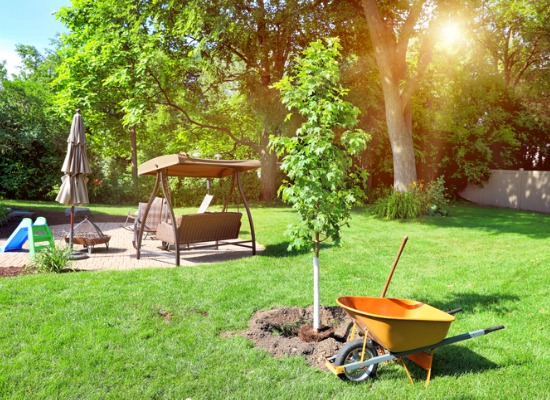TREE EDUCATION

On a hot, Florida summer day, what could be more pleasant than enjoying the outdoors while relaxing in the shade? Shade trees keep our backyards, gardens, and landscapes cool. In addition, trees shading our homes and businesses can help reduce energy-use costs indoors.
In contrast, trees shading walkways, patios, and outdoor spaces increase enjoyment outdoors, reduce the substrate temperature, decrease heat radiating off bricks or stones, and filter outdoor pollutants. What's more, planting Florida native trees invites native pollinators and helps them thrive.
SkyFrog Tree Service lists five native shade trees to plant for the summer. Contact us today to speak with a master arborist about our tree services and to request a free estimate for tree service in Gainesville with insurance.
The most well-known magnolia tree in Florida, the Southern magnolia (Magnolia grandiflora), is a dense and stately tree, growing up to 90 feet in height, and features lustrous, evergreen foliage for an ideal garden-plant backdrop. Additionally, Southern magnolias produce large, cream-colored flowers that give off a citrus smell in both spring and summer. These trees can be planted in either sun or shade, and they prefer moist, well-drained acidic soil. When planting, be sure to provide your Southern magnolia with ample space to grow, ideally in a defined landscape bed, as trees shed leaves and seed pods each spring and may also produce surface roots over time.
Florida elm (Ulmus americana) is an excellent choice for those seeking long-living, native shade trees. An elegant, deciduous tree, the Florida elm dazzles in autumn with golden-yellow foliage. Florida elm trees are moderately tolerant of drought, and they grow tall with a straight trunk and an elegant vase-shaped crown with a symmetrical canopy shade. This tree is quick to grow, reaching 60–80 feet in height and spreading 50–60 feet in width. It has dark green leaves that produce small, green flowers in the spring. Following flower growth, it produces wafer-like seed pods that are a favorite among native birds and other wildlife. Florida elms grow in full sun or light shade. Be sure to schedule regular tree pruning, as is required to keep these trees healthy and avoid damage during storms.
The American hophornbeam (Ostrya virginiana) is an aesthetically pleasing tree with a rounded or oval-shaped crown. This native tree produces attractive reddish-brown bark, yellow fall leaves, and small, wildlife-attracting nutlets during the summer months, giving this tree year-round enjoyment. American hophornbeam typically grows 25–40 feet tall, making it a perfect option for those seeking to plant small-size shade trees in their yards or gardens. This shade tree provides excellent protection to flowers and other plants not tolerant to excessive sunlight, particularly during the summer months.
Hollies make for great shade trees in a variety of different Florida landscapes. The Dahoon holly (Ilex cassine) typically grows 20–30 feet tall, while the East Palatka holly (a hybrid between Ilex cassine and Ilex opaca) can grow to be 30–45 feet in height. Female holly trees produce berries, which are a favorite among several different bird species. Hollies tolerate a wide range of light and soil conditions and are wind-resistant. Additionally, these trees require minimal maintenance and benefit from occasional pruning and removing diseased or dead branches. This broad-leaved evergreen tree provides a significant shade during the summer months, providing relief from the heat to humans and native critters alike.
The Gumbo-limbo (Bursera simaruba) tree is a large-size, fast-growing, and interestingly shaped tree native to southern Florida. These trees are prevalent in hot climates, particularly for lining walkways in urban settings and providing shade in residential areas. Gumbo-limbo trees grow to be 25–60 feet tall when fully mature, though they are usually smaller in the landscape. Its branches grow in a curved, contorted pattern, which offers a unique alternative to more common-shaped trees. Tough and low maintenance, these trees are drought tolerant and highly resistant to strong winds. This semi-evergreen tree is barely ever bare, as new leaves grow just as dead leaves fall.
Have more questions about our insured tree service? Review our tree services FAQs page, or call us to speak with a board certified master arborist!